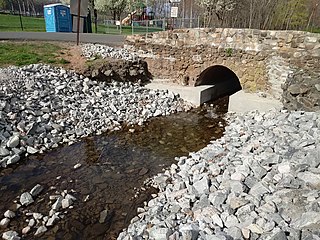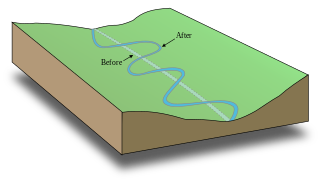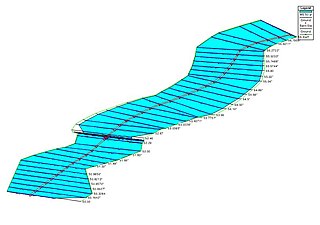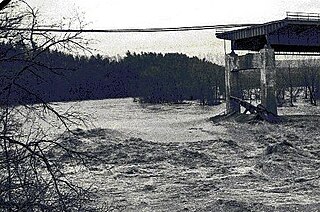Causes
Stream channel instability resulting in river erosion and changing angles-of-attack can contribute to bridge scour. Debris can also have a substantial impact on bridge scour in several ways. A build-up of material can reduce the size of the waterway under a bridge causing contraction scour in the channel. A build-up of debris on the abutment can increase the obstruction area and increase local scour. Debris can deflect the water flow, changing the angle of attack and increasing local scour. Debris might also shift the entire channel around the bridge causing increased water flow and scour in another location. [3]
The most frequently encountered bridge scour problems usually involve loose alluvial material that can be easily eroded. It should not be assumed that total scour in cohesive or cemented soils will not be as large as in non-cohesive soils; the scour simply takes longer to develop.
Many of the equations for scour were derived from laboratory studies, for which the range of applicability is difficult to ascertain. Most studies focussed on piers and pile formations, though most bridge scour problems are related to the more complex configuration of the bridge abutment. Some studies were verified using limited field data, though this is also difficult to accurately scale for physical modelling purposes. During field measurements of post scour, a scour hole that had developed on the rising stage of a flood, or at the peak, may be filled in again on the falling stage. For this reason, the maximum depth of scour cannot be simply modelled after the event.
Scour can also cause problems with the hydraulic analysis of a bridge. Scour may considerably deepen the channel through a bridge and effectively reduce or even eliminate the backwater. This reduction in backwater should not be relied on, however, because of the unpredictable nature of the processes involved.
When considering scour it is normal to distinguish between non-cohesive or cohesionless (alluvial) sediments and cohesive material. The former are usually of most interest to laboratory studies. Cohesive materials require special techniques and are poorly researched.
The first major issue when considering scour is the distinction between clear-water scour and live-bed scour. The critical issue is whether or not the mean bed shear stress of the flow upstream of the bridge is less than or larger than the threshold value needed to move the bed material.
If the upstream shear stress is less than the threshold value, the bed material upstream of the bridge is at rest. This is referred to as the clear-water condition because the approach flow is clear and does not contain sediment. Thus, any bed material that is removed from a local scour hole is not replaced by sediment being transported by the approach flow. The maximum local scour depth is achieved when the size of the scour hole results in a local reduction in shear stress to the critical value such that the flow can no longer remove bed material from the scoured area.
Live-bed scour occurs where the upstream shear stress is greater than the threshold value and the bed material upstream of the crossing is moving. This means that the approach flow continuously transports sediment into a local scour hole. By itself, a live bed in a uniform channel will not cause a scour hole—for this to be created some additional increase in shear stress is needed, such as that caused by a contraction (natural or artificial, such as a bridge) or a local obstruction (e.g. a bridge pier). The equilibrium scour depth is achieved when material is transported into the scour hole at the same rate at which it is transported out.
Typically the maximum equilibrium clear-water scour is about 10% larger than the equilibrium live-bed scour. Conditions that favour clear-water scour include bed material being too coarse to be transported, the presence of vegetated or artificial reinforced channels where velocities are only high enough due to local scour, or flat bed slopes during low flows.
It is possible that both clear-water and live-bed scour can occur. During a flood event, bed shear stress may change as the flood flows change. It is possible to have clear-water conditions at the commencement of a flood event, transitioning to a live bed before reverting to clear-water conditions. Note that the maximum scour depth may occur under initial clear-water conditions, not necessarily when the flood levels peak and live-bed scour is underway. Similarly, relatively high velocities can be experienced when the flow is just contained within the banks, rather than spread over the floodplains at the peak discharge.
Urbanization has the effect of increasing flood magnitudes and causing hydrographs to peak earlier, resulting in higher stream velocities and degradation. Channel improvements or the extraction of gravel (above or below the site in question) can alter water levels, flow velocities, bed slopes and sediment transport characteristics and consequently affect scour. For instance, if an alluvial channel is straightened, widened or altered in any other way that results in an increased flow-energy condition, the channel will tend back towards a lower energy state by degrading upstream, widening and aggrading downstream.
The significance of degradation scour to bridge design is that the engineer has to decide whether the existing channel elevation is likely to be constant over the life of the bridge, or whether it will change. If change is probable then it must be allowed for when designing the waterway and foundations.
The lateral stability of a river channel may also affect scour depths, because movement of the channel may result in the bridge being incorrectly positioned or aligned with respect to the approach flow. This problem can be significant under any circumstances but is potentially very serious in arid or semi-arid regions and with ephemeral (intermittent) streams. Lateral migration rates are largely unpredictable. Sometimes a channel that has been stable for many years may suddenly start to move, but significant influences are floods, bank material, vegetation of the banks and floodplains, and land use.
Scour at bridge sites is typically classified as contraction (or constriction) scour and local scour. Contraction scour occurs over a whole cross-section as a result of the increased velocities and bed shear stresses arising from a narrowing of the channel by a construction such as a bridge. In general, the smaller the opening ratio the larger the waterway velocity and the greater the potential for scour. If the flow contracts from a wide floodplain, considerable scour and bank failure can occur. Relatively severe constrictions may require regular maintenance for decades to combat erosion. It is evident that one way to reduce contraction scour is to make the opening wider.
Local scour arises from the increased velocities and associated vortices as water accelerates around the corners of abutments, piers and spur dykes. The flow pattern around a cylindrical pier. The approaching flow decelerates as it nears the cylinder, coming to rest at the centre of the pier. The resulting stagnation pressure is highest near the water surface where the approach velocity is greatest, and smaller lower down. The downward pressure gradient at the pier face directs the flow downwards. Local pier scour begins when the downflow velocity near the stagnation point is strong enough to overcome the resistance to motion of the bed particles.
During flooding, although the foundations of a bridge might not suffer damage, the fill behind abutments may scour. This type of damage typically occurs with single-span bridges with vertical wall abutments.
Bridge examination and scour evaluation
The examination process is normally conducted by hydrologists and hydrologic technicians, and involves a review of historical engineering information about the bridge, followed by a visual inspection. Information is recorded about the type of rock or sediment carried by the river, and the angle at which the river flows toward and away from the bridge. The area under the bridge is also inspected for holes and other evidence of scour.
Bridge examination begins by office investigation. The history of the bridge and any previous scour related problems should be noted. Once a bridge is recognized as a potential scour bridge, it will proceed to further evaluation including field review, scour vulnerability analysis and prioritizing. Bridges will also be rated in different categories and prioritized for scour risk. Once a bridge is evaluated as scour critical, the bridge owner should prepare a scour plan of action to mitigate the known and potential deficiencies. The plan may include installation of countermeasures, monitoring, inspections after flood events, and procedures for closing bridges if necessary.
Alternatively, sensing technologies are also being put in place for scour assessment. The scour-sensing level can be classified into three levels: general bridge inspection, collecting limited data and collecting detailed data. [5] There are three different types of scour-monitoring systems: fixed, portable and geophysical positioning. Each system can help to detect scour damage in an effort to avoid bridge failure, thus increasing public safety.


















